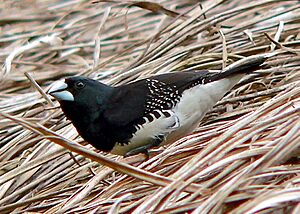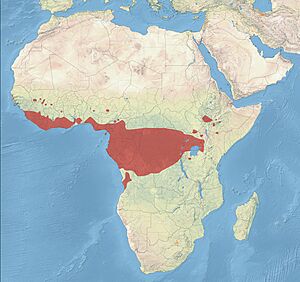Black-and-white mannikin facts for kids
Quick facts for kids Black-and-white mannikin |
|
|---|---|
 |
|
| In Douala, Cameroon | |
 |
|
| Subspecies S. b. nigriceps in Kenya | |
| Conservation status | |
| Scientific classification | |
| Genus: |
Spermestes
|
| Species: |
bicolor
|
 |
|
| distribution | |
The black-and-white mannikin (scientific name: Spermestes bicolor) is a small bird also known as the black-and-white munia or red-backed mannikin. It belongs to a group of birds called estrildid finches, which are often found in warmer parts of the world. This bird lives across a huge area of the African tropical rainforest.
You can find these birds in wet savanna areas and in tropical lowland forests. They mostly eat seeds, but they have also been seen eating algae. Scientists have looked at how many black-and-white mannikins there are and believe they are doing well. Their status is listed as "least concern," meaning they are not currently at risk of disappearing.
Discovering the Black-and-White Mannikin
The black-and-white mannikin was first officially described in 1843. A British scientist and collector named Louis Fraser found a specimen (an example of the bird) near Cape Palmas in Liberia. He gave it the scientific name Amadina bicolor.
Later, scientists decided this bird belonged in a different group, or genus, called Spermestes. This genus was first introduced in 1837 by another scientist, William John Swainson. Today, the black-and-white mannikin is one of four species in the Spermestes genus.
Different Types of Mannikins
Within the black-and-white mannikin species, there are four different types, called subspecies. These subspecies are slightly different from each other, often in their looks or where they live.
- S. b. bicolor (described by Fraser in 1843) – Found from Guinea-Bissau to Cameroon.
- S. b. poensis (described by Fraser in 1843) – Lives from southern Cameroon to southern Sudan, southwest Ethiopia, western Kenya, and the island of Bioko.
- S. b. woltersi (described by Schouteden in 1956) – Found in southeastern DR Congo and northwestern Zambia.
- S. b. nigriceps (described by Cassin in 1852) – Lives from central Kenya and southern Somalia to eastern Angola, Zambia, Zimbabwe, and eastern South Africa.
Sometimes, the S. b. woltersi and S. b. nigriceps subspecies are even thought of as a separate species entirely, known as the red-backed mannikin.


